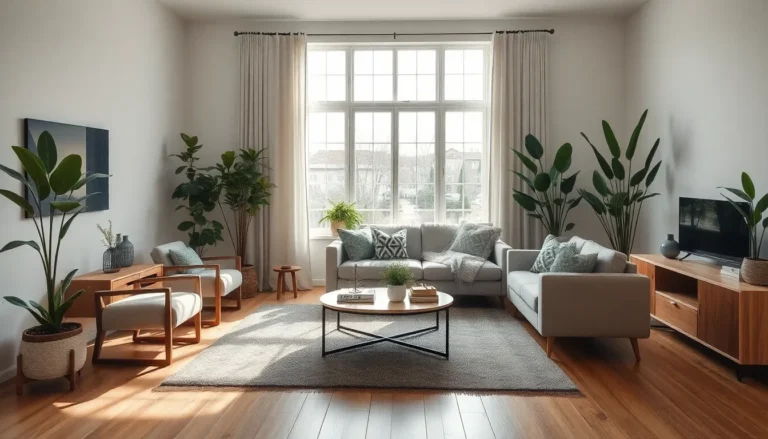Table of Contents
ToggleImagine waking up to a sun-drenched room that feels more like a tropical paradise than a mundane apartment. Natural daylight maximization isn’t just a fancy phrase; it’s the secret sauce to transforming any space into a vibrant haven. By harnessing the power of sunlight, one can boost mood, enhance productivity, and even save on energy bills. Who wouldn’t want a little extra sunshine in their life?
Understanding Natural Daylight Maximization
Natural daylight maximization refers to the strategic use of sunlight within living and working spaces. Enhancing daylight exposure promotes a more inviting atmosphere.
Definition and Importance
Natural daylight maximization involves optimizing window placements, using reflective surfaces, and selecting appropriate materials to increase light flow. This practice plays a crucial role in creating healthier environments. Efficient use of daylight can significantly affect well-being, productivity, and energy efficiency. Implementing these strategies leads to reduced reliance on artificial lighting, translating into lower electricity costs. Architects and designers emphasize this aspect in their plans, recognizing its value.
Benefits of Natural Light
Natural light provides numerous advantages that enhance daily life. Exposure to sunlight improves mood and boosts mental health. Enhanced daylight in workspaces promotes productivity and creativity, leading to higher job satisfaction. Moreover, daylight helps regulate circadian rhythms, positively impacting sleep quality. Energy savings arise when natural light reduces the need for artificial lighting, contributing to a more sustainable living space. Research indicates that spaces filled with natural light can increase property values, making them desirable for both owners and renters.
Techniques for Natural Daylight Maximization
Maximizing natural daylight involves employing various techniques that enhance light flow and ambiance in spaces.
Architectural Design Strategies
Incorporating open floor plans fosters light circulation, creating a more inviting atmosphere. Designers often position rooms with large windows to capture direct sunlight. Employing high ceilings increases light distribution, making interiors feel more expansive. Choosing lighter colors for walls and ceilings reflects light, amplifying brightness throughout the area. Additionally, integrating outdoor elements like patios and balconies can help draw in more natural light.
Use of Windows and Skylights
Strategically placing windows enhances natural light entry while maintaining privacy. A mix of fixed and operable windows allows for ventilation and sunlight maximization. Utilizing skylights brings in overhead light, which brightens areas that might otherwise remain dark. Selecting energy-efficient glass reduces heat gain while allowing ample daylight. Furthermore, incorporating window treatments such as sheer curtains enables light filtering without sacrificing privacy.
Impact on Health and Well-being
Maximizing natural daylight significantly enhances health and well-being. Its benefits extend to both psychological and physical aspects, shaping a healthier lifestyle.
Psychological Effects
Natural light influences mental health by elevating mood and reducing feelings of anxiety. Increased exposure to sunlight contributes to higher serotonin levels, promoting a sense of happiness and calm. Individuals often report improved focus, which translates to greater productivity at work or home. Enhanced creativity can also arise in well-lit environments. People frequently experience less fatigue and stress when surrounded by ample daylight. A vibrant atmosphere fosters social interaction, boosting overall life satisfaction and emotional wellness.
Physical Health Benefits
Natural daylight encourages better sleep patterns by regulating circadian rhythms. Exposure to sunlight during the day promotes alertness, while evening darkness signals the body to prepare for sleep. Enhanced vitamin D levels also play a vital role in calcium absorption, supporting bone health and immune function. Natural light reduces dependency on artificial lighting, resulting in energy savings. Improved indoor air quality often accompanies well-lit spaces, as proper ventilation becomes easier with strategic window placement. Research shows a direct correlation between well-lit environments and lower rates of illness, emphasizing the importance of optimizing natural light.
Natural Daylight Maximization in Different Settings
Natural daylight maximization enhances living and working environments, creating vibrant and healthier spaces.
Residential Spaces
Residential areas benefit significantly from natural light maximization. Strategically placed windows and open floor plans allow sunlight to permeate throughout homes. Light-colored walls and reflective surfaces can amplify illumination, creating an airy feeling. Skylights provide additional light sources, especially in rooms with limited windows. More daylight leads to improved mood and better sleep patterns, contributing to overall well-being. Research shows that homes filled with natural light have higher property values, attracting potential buyers.
Commercial Properties
Commercial properties leverage natural daylight to boost productivity and employee satisfaction. Optimizing window placements and using energy-efficient glass ensures ample light without excessive heat gain. Open spaces encourage light flow, while adjustable shades provide control over glare and heat. Enhancing workspaces with natural light has proven to reduce stress and increase focus among employees. Businesses can experience lower energy costs due to reduced reliance on artificial lighting. Studies indicate workplaces with abundant natural light promote happier and healthier employees, improving retention rates.
Technologies Supporting Daylight Maximization
Innovative technologies play a critical role in maximizing natural daylight in living spaces. These solutions enhance light flow while promoting comfort and energy efficiency.
Smart Glass and Window Technology
Smart glass systems adjust their transparency based on sunlight intensity. These technologies offer significant benefits, including glare reduction and energy savings. Users enjoy natural light without the discomfort of harsh sunlight. Furthermore, variable transparency gives occupants control over brightness, enhancing interior comfort. Self-tinting windows help manage heat and light levels, contributing to overall energy efficiency. Studies show that utilizing smart glass can lower energy costs by up to 30%, making it an attractive option for both residential and commercial spaces.
Light Shelves and Reflective Surfaces
Light shelves distribute daylight deeper into interior spaces. By reflecting sunlight off surfaces, these fixtures enhance overall illumination. Designers often incorporate light shelves into building layouts to optimize light entry without compromising privacy. Reflective surfaces, such as light-colored walls and ceilings, also play a vital role. These surfaces amplify the impact of natural light, reducing the need for artificial lighting. The effective use of light shelves and reflective materials can improve energy efficiency, creating more inviting and well-lit environments.
Maximizing natural daylight is more than just an aesthetic choice; it’s a pathway to healthier and more productive living and working environments. By strategically incorporating sunlight into design, individuals can experience enhanced mood, improved well-being, and significant energy savings.
The benefits extend beyond personal comfort, influencing property values and workplace satisfaction. Innovative technologies and thoughtful architectural choices can transform spaces into inviting havens filled with light. Embracing natural daylight not only enriches daily life but also fosters a sustainable approach to energy consumption.
Investing in natural light is an investment in health happiness and efficiency.







